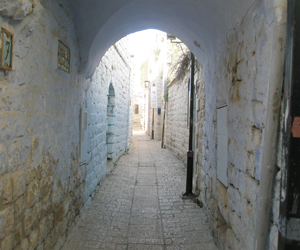Tzfat's Artist Quarter
Changing City
Few people believe the old-timers when they talk about Tzfat as it was 50 years ago. Today's religious-leaning town was, only a few decades ago, Israel's bohemian center. There were few religious schools and no kosher restaurants. The municipality administration was decidedly secular, and Tzfat's image was that of a laid-back "happening" artists' village. When the famous artists of the '50s and '60s stopped coming to Tzfat as they aged, more families and religious people took their place, and the atmosphere changed.
Today, the artist's community is reinventing itself, and slowly coming back to life. Religious artists are bringing their faith and learning into their work, and many Russian immigrant artists are attracted to Tzfat, opening galleries and making their mark on the city.
The great artists of Tzfat, however, will never be forgotten, and the Artists Quarter that they created continues to guide and shape the new Artists Quarter which is emerging.
The Original Artists Of Safed
Moshe Castel and Yitzhak Frenkel are two artists who came to Tzfat immediately after the 1948 War of Independence. A few early artists, including the famous Shalom of Safed (best-known for his pioneering microcalligraphy art) had set up galleries in Tzfat in the 1930s, so following the War of Independence, it seemed natural for other artists to join them. Yosl Bergner, who anthropomorphized inanimate objects in his allegorical works and sculptor/painter Menachem Shemi are some of the other better-known artists who set up galleries in Tzfat.
Today, the names of Tzfat's early artists bring nods of recognition, as their paintings and sculptures are acknowledged throughout the world as some of the period's best art. Non-artist residents of the area who lived during that time remember the artists as struggling to put food on their tables. One elderly couple used to cook a large pot of stew every day which fed many of the artists -- artists who would go on to become household names in the homes of art collectors in future years.
Many of the artists who opened galleries in Tzfat were Holocaust survivors, and their art was influenced by their experiences. Others had left Europe before Hitler took power, or during the early years of Nazi Germany, but their families had been wiped out, and this, too, impacted on their art. Yet some, like the beloved Rika Schwimmer, deliberately ignored their tragic experiences as they sought to infuse their art with light and joy.
Mordehay Levanon, Ziona Tagar and Shimshon Holtzman are some of the great Israeli artists whose galleries dotted the Tzfat Artist Quarter. They themselves eagerly awaited their summers in Tzfat when they gathered together with other artists to develop the professional camaraderie of an artist's community. Yet these, and others such as Raviv and David Gilboa, were the figures who created the Israeli art scene which today continues to be influenced by these great artists.
The work of many of these early artists can today be seen at the General Exhibition of the Artists Quarter.

